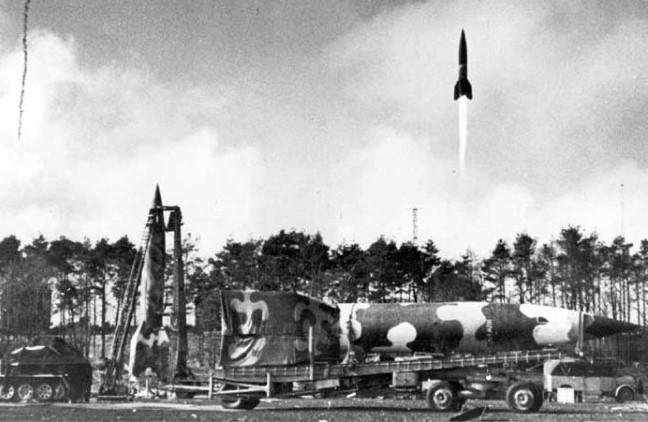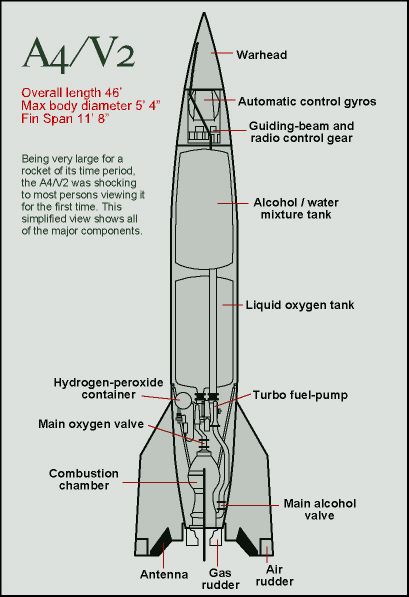The V-2

V-2 Preparation and Launch
Source: http://www.kheichhorn.de/html/body_v2-a4.html
The V-2 was the first of Von Braun’s world-stunning achievements. He was the mastermind that oversaw the overall design of the system. The first V-2 was launched at London on September 1944. Up to 3000 would be launched up to the end of the war. Test rockets were painted with a black and white checkered pattern so observers could note how rapidly it was spinning in test flight. Combat rockets were painted in green and brown camouflage.
Components of the V-2:
A Cross-Section of the V-2
Source: http://www.v2rocket.com/start/makeup/design.html
Warhead:
The 100 kg of Amatol, a relatively stable but deadly explosive compound, is what gave the V-2 the ability to level a city block, and was located at the tip of the rocket.
Gyro-compass:
The Gyro-compass was a more advanced device than that of the V-1’s. It calculated deviations from the trajectory and sent them via radio signals to the air and gas vanes.
Fuel Tanks:
The fuel used by the V-2 was a mixture of alcohol and water. The fuel tank was located under the Gyro-compass and fuel was transported to the combustion chamber via a steam powered rotary pump that tubed it through the rest of the structure.
Underneath the Alcohol Tank was the liquid oxygen tank, which combined with the Alcohol to form highly a combustible fuel compound. The liquid oxygen was injected into the combustion chamber via another steam powered tube.
Combustion chamber:
The Alcohol and liquid oxygen were brought to the bell-shaped combustion chamber via the steam pump, where they were then ignited and created the thrust to propel the rocket.
Performance:
V-2 Test Launch
Source: http://www.wehrmacht-history.com/images/heer/missiles/v-2-rocket-2.jpg
The V-2 would propel itself for roughly 60 seconds from lift-off. During this time the temperature inside the combustion chamber would reach about 2500 degrees Celsius. The maximum height in its trajectory was about 88 km above the surface; exiting and re-entering the stratosphere. Its impact velocity was over 900 m/s; faster than the typical rifle bullet. Its victims would not be able to hear the sound of it coming, until it was too late.
V-2 in Test Descent
Source:https://southcarolina1670.wordpress.com/2012/04/03/british-recover-tail-fin-from-v2-rocket/
The V-2 was a thorn in the side to Allied morale, but it was not a war-winner, and there are valid arguments that it was cost-inefficient, especially considering only 100 kg out of 12,500 kg (0.8%) of the rocket’s mass was explosive material that dealt damage to the target. Many historians believed that, while the V-1 was cost-efficient because of its simple design, the money and material for the V-2’s could have been better spent elsewhere. However, the V-2 was a career success for Wernher Von Braun because the science behind it impressed the Allies and compelled them to have the desire to recruit him and scientists like him.
Title Page
Introduction
Early Life
The V-1
The V-2
NASA and the Saturn V
Death and Legacy
Bibliography


